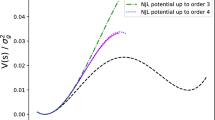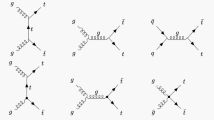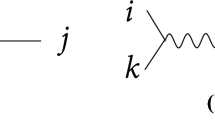Abstract
A new method for calculating the contribution of two-boson exchange diagrams (boxes) to the cross section for a four fermion process that involve one and two complex-valued boson masses is described. A detailed numerical analysis of the results obtained by means of this method and their comparison with the asymptotic expressions for the above cross section in the regions of energies below and above the \(Z\)-resonance energy are performed.










Similar content being viewed by others
REFERENCES
J. Kahane, Phys. Rev. B 135, 975 (1964).
G. ’t Hooft and M. Veltman, Nucl. Phys. B 153, 365 (1979).
W. Spence, An Essay on the Theory of the Various Orders of Logarithmic Transcendents (John Murray and Archibald Constable and Co., London, 1809).
A. Denner, U. Nierste, and R. Scharf, Nucl. Phys. B 367, 637 (1991).
M. Böhm, H. Spiesberger, and W. Hollik, Fortschr. Phys. 34, 687 (1986).
G. J. van Oldenborgh and J. A. M. Vermaseren, Z. Phys. C 46, 425 (1990).
T. Hahn and M. Pérez-Victoria, Comput. Phys. Commun. 118, 153 (1999); hep-ph/9807565.
R. P. Feynman, Phys. Rev. 76, 769 (1949).
P. G. Lepage, J. Comput. Phys. 27, 192 (1978).
T. Hahn, Comput. Phys. Commun. 168, 78 (2005); hep-ph/0404043.
A. V. Smirnov and M. N. Tentyukov, Comput. Phys. Commun. 180, 735 (2009); ar**v: 0807.4129 [hep-ph].
S. Borowka, G. Heinrich, S. P. Jones, M. Kerner, J. Schlenk, and T. Zirke, Comput. Phys. Commun. 196, 470 (2015); ar**v: 1502.06595v2[hep-ph].
E. Remiddi and J. A. M. Vermaseren, Int. J. Mod. Phys. A 15, 725 (2000); hep-ph/9905237.
C. Bauer and H. S. Do, Comput. Phys. Commun. 144, 154 (2002); hep-ph/0102231.
J. Broedel, C. Duhr, F. Dulat, B. Penante, and L. Tancredi, J. High Energy Phys. 1905, 120 (2019); ar**v: 1902.09971[hep-ph].
G. Passarino and M. Veltman, Nucl. Phys. B 160, 151 (1979).
Particle Data Group (P. A. Zyla et al.), Prog. Theor. Exp. Phys. 2020, 083C01 (2020).
V. A. Zykunov, Perturbative Calculations in High Energy Physics (GGU im. F. Skoriny, Gomel’, 2020) [in Russian].
V. A. Zykunov, Phys. Rev. D 75, 073019 (2007); hep-ph/0509315.
A. Andonov, A. Arbuzov, D. Bardin, S. Bondarenko, P. Christova, L. Kalinovskaya, G. Nanava, and W. von Schlippe, Comput. Phys. Commun. 174, 481 (2006); hep-ph/0411186.
U. Baur, O. Brein, W. Hollik, C. Schappacher, and D. Wackeroth, Phys. Rev. D 65, 033007 (2002); hep-ph/0108274.
J. Gao, M. Guzzi, J. Huston, H.-L. Lai, Zh. Li, P. Nadolsky, J. Pumplin, D. Stump, and C.-P. Yuan, Phys. Rev. D 89, 033009 (2014); ar**v: 1302.6246[hep-ph].
C. Buttar, J. D’Hondt, M. Krämer, G. Salam, M. Wobisch, N. E. Adam, V. Adler, A. Arbuzov, D. Bardin, U. Baur, A. A. Bhatti, S. Bondarenko, V. Buge, J. M. Butterworth, M. Cacciari, M. Campanelli, et al., in Proceedings of the Workshop on Physics at TeV Colliders (Les Houches, 2007), p. 121; ar**v: 0803.0678[hep-ph].
ACKNOWLEDGMENTS
I am grateful to my colleagues from the RDMS CMS group and Yu.M. Bystritskiy for discussions.
Funding
This work was supported by the Convergence-2020 Research Program of Republic of Belarus (Microscopic World, Plasma, and Universe Subprogram). The numerical calculation of the relative corrections to the Drell–Yan process by means of the READY code was performed at the HybriLIT heterogeneous computing cluster of Laboratory of Information Technology at Joint Institute for Nuclear Research (JINR, Dubna).
Author information
Authors and Affiliations
Corresponding author
Appendices
Appendix A
CALCULATION OF THREE-BODY FUNCTIONS
The scalar three-body functions \(H_{0}\) appearing in Eq. (35) has the form
Integrals of this type are readily calculable by the ’t Hooft–Veltman method [2] (for a detailed calculation, see, for example, [18]). For the case of \(a=\gamma\), a compact expression that is symmetric with respect to the substitution \(m_{q}\leftrightarrow m_{l}\) arises, as a result, in the ultrarelativistic approximation. Specifically, this expression has the form
The substitution \(t\rightarrow u\) leads to a similar expression for \(H_{0}^{\gamma}\left(p_{1},p_{4}\right)\).
The scalar three-body function \(F_{0}\) appearing in Eq. (35) is given by
It can readily be reduced to the form (A.1) by means of the substitution \(k\rightarrow k+q\) (the equality \(F_{0}^{b}=H_{0}^{b}\) is proven in this way) and then be calculated by the method developed in [2]. For the case of \(b=Z\), the result has the form of a nontrivial combination of 12 dilogarithms. It will be shown here how the method applied to four-point functions can be used to obtain simple expressions for the case of three-point functions as well.
Thus, the integral in question assumes the following form after the change of integration variable:
Setting \(A=k^{2}-m_{Z}^{2}\), \(B=k^{2}-2p_{1}k\), and \(C=k^{2}-2p_{3}k\), we obtain
After some algebra, we arrive at
The square of the 4-vector \({\mathcal{P}}\) is positive at any point of the integration domain:
Removing the integral according to the well-known formula
we obtain
As a result, we arrive at the following compact expressions:
The analytic result obtained by the method developed in [2] is also given here for the sake of comparison (a detailed derivation of it can be found in [18]). Ultimately (we have maximally sextuple embedding of expressions), it depends on six parameters
and has the form of combinations of dilogarithms:
A dilogarithm, which is a specific form of a polylogarithm, is defined for \(z\in{\mathbb{C}}\) as
In order to calculate dilogarithm values to the required precision, use is made of the following power-series expansion: \({\textrm{Li}}_{2}(z)=\sum_{k=1}^{\infty}\frac{z^{k}}{k^{2}}\). For the argument \(z\) to be within the convergence region, the dilogarithm is usually reduced to a combination of a dilogarithm of some other argument and other functions by means of one of the numerous available identities, for example,
In expression (A.9) \(\beta=c+2\alpha b\) and the remaining coefficients are the following:
The expression for \(\alpha\) is taken to be double-valued, but the ultimate result is independent of the choice of sign:
The expressions for \(y^{\pm}_{i}\) are roots of the equation \(A_{i}y^{2}+B_{i}y+1=0\), where the coefficients depend on \(K_{0}\) and \(\gamma\) (\(K_{0}=by_{0}^{2}+ey_{0}+f\) and \(\gamma=2by_{0}+e\)), so that we have
Appendix B
TABLE OF INTEGRALS
The calculation involved the following integrals:
The calculated expressions have the form
Use is made of the following condensed notation:
At the resonance point \(q^{2}=m_{Z}^{2}\), we obtain
Appendix C
ASYMPTOTIC FORMULAS FOR THE LE AND HE MODES
In order to obtain the LE expressions for the \(\gamma Z\) box, it is necessary to make use of the general expression in terms of the coefficients and to set to zero all of them, with the exception of \(b_{0}\) and the integral \(H_{0}^{\gamma}\) from \(I_{0}\) (for a proof of this, see, for example, [18] and references therein). For \(b_{0}\) (direct box), we use the following asymptotic expression:
For the \(ZZ\) box, only the tensor coefficient \(b_{0}\) is of importance:
In order to obtain HE formulas, we make use of the asymptotic expressions for the direct boxes (they are applicable for all of the cases: \(ab=\gamma\gamma\), \(\gamma Z\), \(ZZ\), and \(WW\)):
For the crossed boxes, we obtain
where \(C_{i\pm j}^{abc}=C_{i}^{abc}\pm C_{j}^{abc}\). Also, use is made here of the following condensed notation:
The three-point functions in front of the propagator structures factorize; that is,
We will now write explicitly the infrared-divergent parts of the \(\gamma\gamma\) box. We have
where the ‘‘Born’’ term \(R_{q}\) [see Eq. (15)] is related to the combinations \(C_{3,4}\) by the equations
The infrared-divergent parts of the \(\gamma Z\) box are identical in form to expressions (A.21):
Clearly, the infrared-divergent parts of the \(Z\gamma\) box make the same contribution; therefore, doubling occurs in the sum. As a result, the infrared-divergent part of the cross section for the box diagrams has the form
where
Appendix D
COMPENDIUM OF SIMPLIFIED EXPRESSIONS
For the reference purposes, given immediately below is a simplified version of the formulas for the real part of the cross section for the two-boson exchange; that is,
where the coefficients in the cross section (their origin can readily be traced in the main body of the text) are given by
Expressions (A.25) and (A.26) are applicable for all cases (\(\gamma Z\) and \(ZZ\)), but the coefficients \({\mathcal{C}_{0,1}}\) and \({\mathcal{B}_{0,4}}\) are different. They are presented here explicitly. For the \(\gamma Z\) box, \({\mathcal{C}_{0,1}}\) and \({\mathcal{B}_{0,4}}\) are given by
For the direct \(ZZ\) box, the expressions for \({\mathcal{C}_{0,1}}\) and \({\mathcal{B}_{0,4}}\) have the form
The expression for \(H_{0}^{\gamma}\) is given by Eq. (A.2), while the expression for \({\mathcal{E}}\) is given by Eq. (A.8). The expressions for \(\mathcal{Y}_{\mathcal{A},\mathcal{B},\mathcal{S}}\) are presented in Appendix B. They depend on the coefficients \(\mathcal{A}\), \(\mathcal{B}\), and \(\mathcal{C}\), whose values are given in Table 1 for various boson configurations in the direct diagram.
Rights and permissions
About this article
Cite this article
Zykunov, V.A. Calculation of Two-Boson Exchange with Complex-Valued Masses. Phys. Atom. Nuclei 84, 1225–1243 (2021). https://doi.org/10.1134/S106377882105015X
Received:
Revised:
Accepted:
Published:
Issue Date:
DOI: https://doi.org/10.1134/S106377882105015X




